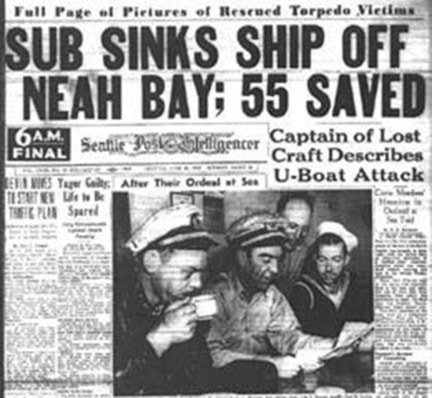Because Capt. Havens had contented himself with posting lookouts but not sailing a defensive course, the Japanese submarine had easily closed to within firing range.
Shipwrecks have long been a favourite of my mine hence I’ve made them the subject of several hundred columns and articles and two books over the years. So I was intrigued by a June report in the Vancouver Sun that the sunken hulk of the freighter Coast Trader has been found and is being investigated to determine if its rusting oil tanks are a potential environmental hazard.
Although just a nondescript workhorse in peacetime, the 22-year-old, 3,286-ton Trader made naval history of sorts for being the second merchant vessel to be sunk off the Pacific Coast during the Second World War. Sailing under charter to the U.S. Army from Port Angeles to San Francisco with a cargo of newsprint, she was torpedoed off the entrance to Juan de Fuca Strait, 35 miles southwest of Cape Flattery, June 7, 1942. This was six months after the same Japanese submarine sank the first American merchantman of the war on the first day of the war, Dec. 7, 1941. That victim, the Honolulu-bound SS Cynthia Olson, went down with all of her 35-man crew; happily for the 57 men aboard the Trader, despite some injuries from the explosion, there was but a single fatality.
Two weeks after sinking the Trader, the I-26 would shell Vancouver Island’s Estevan Point lighthouse.
Unaccountably, despite repeated sightings of Japanese submarines off the west coast, and at least 15 attacks on merchant shipping over the previous six months, Capt. Lyle Havens had contented himself with posting lookouts but not sailing a defensive course. Consequently, the I-26, running at periscope depth, had easily closed to within firing range.
According to HistoryLink.org, the torpedo that struck the Trader just aft of her No. 4 hatch, shortly after 2 o’clock on Sunday afternoon of June 7, blew off the hatch covers, sent 2,000-pound rolls of newsprint flying into the air and toppled her mainmast and radio antenna.
Engines stopped, her holds filled with steam and ammonia fumes from her refrigeration. It overcame some of the crew as they began lowering the lifeboats.
As her radio operator continued to send SOS signals despite her broken radio antenna, they managed to launch the port lifeboat and two cork rafts and to evacuate the ship in calm seas. The ill-fated Coast Trader slowly sank, stern-first, 40 minutes after she was hit.
A halibut schooner picked up the survivors in the lifeboat late the next day after they’d rowed all through the night in the belief that their distress signals hadn’t been heard. By the time the fishboat arrived, however, the weather had turned stormy, with 60-knot winds, and the lifeboat had become separated from the rafts. Those in the boat, by this time cold, wet and miserable, the injured suffering from their unattended wounds, were taken to the Coast Guard station at Neah Bay.
It was dawn of June 9, some 40 hours after they abandoned ship, before a search aircraft spotted the rafts. The Canadian corvette HMCS Edmunston picked up the remaining survivors but too late, sadly, for 56-year-old cook Steven Chance who’d succumbed to exposure.
Ironically, the U.S. government was loathe to admit that this had happened so close to its shores and the sinking of the Coast Trader was attributed, not to a torpedo, but to “an internal explosion”. And so the record shows to this day.
The Trader’s hulk, largely intact, was recently found 140 metres down and just inside Canadian waters — not in Washington’s Olympic Coast National Marine Sanctuary as was long believed. Last month, underwater archaeologists joined with James Ballard’s Ocean Exploration Trust of the Titanic fame to examine the Trader with a robotic submersible.
She’s one of 87 shipwrecks of concern to U.S. National Oceanic and Atmospheric Administration for their potential to leak harmful pollutants as they continue to deteriorate; the Coast Trader was carrying more than 7,000 barrels of heavy Bunker C fuel.
To date, it appears that they haven’t leaked — which is just as well as their contents will, according to computer projections, wash ashore on Vancouver Island’s west coast.
